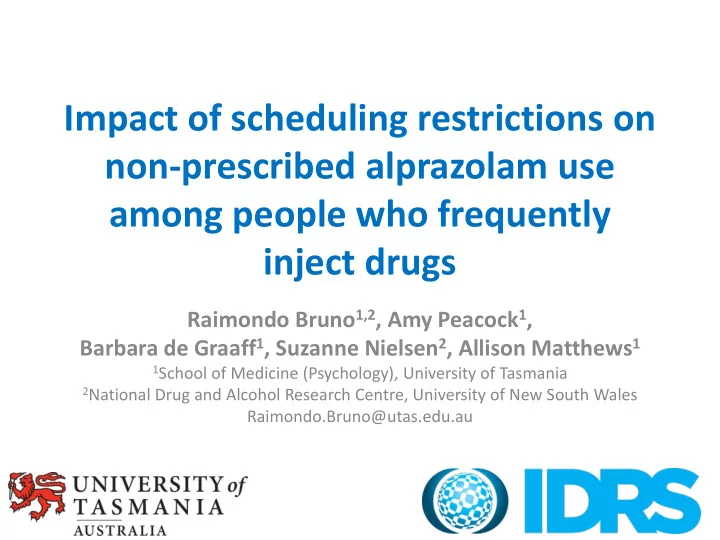

Impact of scheduling restrictions on non-prescribed alprazolam use among people who frequently inject drugs Raimondo Bruno 1,2 , Amy Peacock 1 , Barbara de Graaff 1 , Suzanne Nielsen 2 , Allison Matthews 1 1 School of Medicine (Psychology), University of Tasmania 2 National Drug and Alcohol Research Centre, University of New South Wales Raimondo.Bruno@utas.edu.au
Alprazolam use in Australia All Anxiolytic Prescriptions Subsidised Alprazolam Prescriptions
‘Illicit’ alprazolam use in IDRS samples % using in last 180 days Days used out of last 180 100 90 90 80 80 70 70 60 60 50 38.5 37.3 50 34.8 40 40 30 30 20 20 10 10 8 7 10 0 0 2011 2012 2013 2011 2012 2013
Why is this an issue? Escalation of sudden/unnatural deaths involving alprazolam in NSW 1997: 3 2012: 86 2010-12 >44 deaths p.a. accidental OD, ~80% PWID, 90% opioid+alpraz Chronic BZD impairs cognition (meta analysed: d= -0.74 ) Cognitive impairment NON- REVERSED following abstinence (meta analysed: d= -0.48) BZD use (any) associated with increased risk of dementia <91 LT DDD OR 1.09 91-180 LT DDD OR 1.32* >180DDD OR 1.84* (controlling for confounders)
Increased adverse correlates with alprazolam use Incrementally greater IDRS No BZD use BZD use Alpraz use adverse events associated 2011-13 (n=488) (not alpraz) (± other BZD) with alprazolam use (n=315) (n=641) • Poorer MH function (SF- % AOR % % AOR 12 MHS -2SD) despite Male 70 1.12 66 65 0.86 controlling for anxiety dx Unst. Accom 20 0.90 22 29 1.20 • Greater crime Daily IDU 40 1.10 39 46 1.34 involvement despite controlling for IDU 38 0.71* 49 59 1.42* OST frequency, Anx dx 14 0.56* 26 33 1.16 unemployment Ψ distress 21 0.62** 35 49 1.41* Relationship between days alprazolam use and days Arrested 29 1.19 27 45 1.61** crime sig even after Any crime 29 0.97 33 49 1.37* controlling for frequency of other BZD use Controlling for: age, sex, education, unemployment, accommodation, frequency of injection, drug types injected, OST, health service utilisation, physical function, sharing, anxiety dx
What’s changed? • Feb 1, 2014: National up-schedule from Schedule 4 (prescription only) to Schedule 8 (controlled drug) – Pfizer withdraws alprazolam as of December 2013 • Practically, what does this mean? – Generally: • If declared drug dependent person immediate authority required • Otherwise ~8 week ‘grace period’ THEN authority required
Did alprazolam use change in 2014? Alprazolam Use 2013 vs 14 Frequency of illicit use 2013 vs 14 2013 2014 p 90 N=887 N=898 80 Any licit 9.5% 7.2% 0.105 70 (n=84) (n=65) 60 Days licit 158 74 0.065 50 (1-180) (1-180) 40 Any illicit 34.8% 26.9% <0.001* 30 (n=309) (n=242) 20 Days illicit 8 6 0.134 8 10 6 (1-180) (1-180) 0 Any IV 5.1% 3.0% 0.036* 2013 2014 (n=45) (n=27) p=0.134 Days IV 4 4 0.870 (1-180) (1-100) Source: 2014 National IDRS PWID interviews
Did prices change in 2014? Prices paid for alprazolam Price change since Feb n=117 2013 2014 M-W p 100% 90% 0.25mg - - 80% 0.5mg 0.637 70% $3 (3-5) $3 (1-5) 60% 50% n=3 n=3 50% 43% 1.0mg $5 (2-10) $5 (2-15) 0.554 40% 30% n=7 n=7 20% 0.008** 2.0mg $5 (1-20) $7 (2-40) 5% 10% 3% n=114 n=101 0% Source: 2014 National IDRS PWID interviews
Did availability change in 2014? Ease of access post-policy change Change in access post policy (n=126) change (n=130) 100% 100% 90% 90% 80% 80% 70% 70% 61% 60% 60% 46% 50% 50% 40% 40% 26% 30% 30% 22% 19% 20% 20% 13% 8% 5% 10% 10% 0% 0% Very Difficult Easy Very Easy More No Easier Fluctuates Difficult difficult Change Source: 2014 National IDRS PWID interviews
Attributions: what caused you to change your alprazolam use? N=194 Still using it post the policy change 67% (n=130) Harder to access 16% (n=31) Price increase 2% (n=4) Prescriber shifted me to other medications 2% (n=4) Not interested in it 7% (n=14) Experienced adverse events from the drug 3% (n=6) Friends have experienced adverse events 2% (n=4) Source: 2014 National IDRS PWID interviews
So, what’s the upshot of all this? • Rescheduling has produced some reduction in extramedical use – Use ↓ , price ↑ , availability ↓ • However, 2/3 of those using pre-regulatory change continued to use • What else might have an impact on use? – Peer-led interventions? (health behaviour change models)
Recommend
More recommend